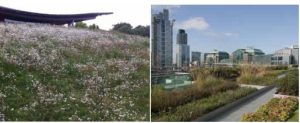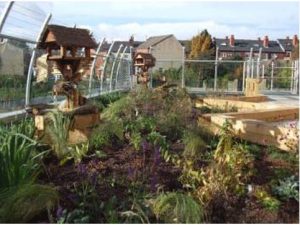When most people think of drainage they think of pipes in the ground, however, today we are looking at a drainage system that can be installed on your roof.
Welcome to our next instalment of our deep dive into the world of Sustainable Drainage Systems (SuDS) where this week we are heading to the top of your development and looking at how green roofs can be used as part of your drainage system.
So what is a green roof?
A green roof is simply a roof that has been partially or fully covered by vegetation and is sometime also referred to as a living roof. They sit right at the top of the hierarchy meaning that they not only provide attenuation from a drainage point of view but also improve water quality, promote biodiversity and provide opportunities to create amenity spaces.
There are predominantly two types of systems and which one you go for really depends on your project and access requirements. They can either be:
- Extensive Roofs – These are specified when access to the roof is not important. They are relatively lightweight as a result of low substrate depths and generally incorporate low maintenance planting which is fairly wind, drought and frost resilient.
- Intensive Roofs – Also known as roof gardens these can be used where there is a requirement for the roof to be used as a recreational space. They have a much deeper growing medium which can accommodate a more complex landscape strategy however, as a result they do usually require more maintenance than a traditional roof.
Figure 1: Example of Extensive (Left) and Intensive (Right) green roofs

Source: CIRIA SuDS Manual Version 6 (C753)
Where can they be used?
Basically, if your development has a roof there is an opportunity to make it green. It does not matter if your project is large or small, residential or commercial a green roof can provide the opportunity of bringing a range of benefits to your project.
Some of my favourite applications of green roofs are in the educational sector where intensive roofs can be used to create outdoor learning areas and provide opportunities to reconnect children with nature.
A brilliant example of this is the installation of a green roof by Sheffield City Council at Sharrow Primary School. The project involved the design and construction of a new 2000m2 green roof which created play space as well as outdoor classrooms. It was also the first green roof in the country to be declared a nature reserve. Further information on the project can be found at the link below.
https://www.greenroofs.com/projects/sharrow-primary-school/
Figure 2: Green roof at Sharrow Primary School, Sheffield

Source: https://www.greenroofs.com/projects/sharrow-primary-school/
So what are the benefits in terms of drainage?
Green roofs help to mimic the natural runoff profile by allowing some of the rainfall to be taken up by the vegetation or through evaporation meaning that less of it needs to be accommodated in your below ground drainage system.
Data released by Baulder who are a green roof specialist state that extensive roofs with a 20-40mm of substrate can retain 40% of average rainfall while for intensive roofs with 500mm of substrate has the capability of storing up to 90% of the average rainfall.
This means that attenuation features on the ground can be smaller requiring less excavation and leaving more space for other services.
Are there any other advantages?
There are many advantages of using green roofs on your development, with some of the main ones being:
- No additional land take as the attenuation requirement is being provided through what would traditionally be an underutilised asset.
- Improvement of air quality as the vegetation can help to filter out both dust particles and gas pollutants.
- Can insulate the building against extremes in temperatures leading to a reduction in heating costs in the winter and cooling costs in the summer.
- Can be used to absorb sound so could be particularly beneficial adjacent to airports, motorways, etc.
This all sounds too good to be true? What are the downsides?
- Green roofs generally cost more than conventional roofs due to the increased structural requirements, this can be offset however by some of the additional benefits they can provide.
- For intensive roofs there can be an increased requirement for maintenance.
- As the roof is designed to store water it means that any damage to the membrane could be more critical.
Summary
Green roofs are a fantastic way of utilising what would be dead space to help meet your attenuation requirements. They can bring a raft of benefits to your project and enhance your outdoor space creating opportunities for people to interact more with nature.
If you want to know more why not check out some of the links included within this article or get in touch where we will be happy to advise on how a green roof might benefit your project.